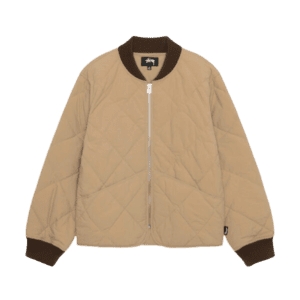In today’s streetwear scene, Stussy jackets are a must-have, but the rise of counterfeits makes it harder than ever to find the real deal. Many buyers end up spending their hard-earned money on fakes, missing out on the quality, comfort, and style that make Stussy iconic. In this guide, we’ll walk you through key details, from stitching to tags, so you can confidently identify an authentic Stussy jacket and avoid costly mistakes.
Check the Branding Details
Logo Placement
An authentic Stussy jacket will always feature precise and consistent logo placement. The brand’s iconic script should be centered or aligned exactly as intended by the design, without tilting or uneven spacing. Any off-centered logo or oddly placed branding is often a red flag.
Logo Quality
The logo on a genuine Stussy jacket will be crisp, clean, and clearly printed or embroidered. The lines should be smooth and the stitching should be tight without loose threads. Faded, blurry, or uneven lettering is a strong sign of a counterfeit.
Consistent Brand Fonts
Stussy has a unique, recognizable font style that is consistent across all their products. Counterfeits often get the font wrong—letters may be stretched, condensed, or slightly misshapen. Comparing the font to an image from Stussy official website can quickly reveal discrepancies.
Inspect the Jacket Construction
Stitching Quality
The quality of stitching is one of the easiest ways to spot an authentic Stussy jacket. The stitches should be even, straight, and without any loose threads. Counterfeit jackets often have messy stitching, gaps, or threads that unravel easily.
Material and Fabric Feel
Stussy jackets are made from premium materials, whether it’s cotton, polyester blends, or nylon. When you touch the fabric, it should feel sturdy yet comfortable, not cheap or flimsy. If the material feels unusually rough, thin, or overly shiny, it may be a fake.
Lining and Interior Finish
Inside a genuine Stussy jacket, you’ll find a well-finished lining that complements the exterior fabric. The lining should feel smooth and be securely stitched in place. Fakes often skip quality lining or use poorly attached, uncomfortable materials.
Examine the Labels and Tags
Neck Label
An authentic Stussy jacket will have a neck label with the brand name clearly printed, often alongside size and manufacturing details. The label should be neatly stitched without crooked seams or misaligned text.
Care Label
Inside the jacket, you’ll find a care label that provides washing instructions, material composition, and the country of manufacture. On genuine products, the text is clear, properly spaced, and free from spelling errors. Counterfeits often have blurry printing or incorrect care symbols.
Authenticity Codes and Extras
Some Stussy jackets feature authenticity tags, QR codes, or holographic stickers depending on the release. Scanning these codes or comparing the hologram’s quality to official examples can help verify legitimacy. Fake products may include imitation stickers that look dull or poorly printed.
Research the Product Release
Compare to Official Photos
Before buying, compare the jacket to official product images from Stussy’s website or trusted retailers. Look for differences in color, logo size, or stitching patterns. Even small variations can indicate a counterfeit.
Check Collection Details
Many Stussy jackets belong to specific seasonal collections or collaborations. Knowing which year and collection your desired jacket comes from can help you identify authentic features and limited-edition details.
Avoid “Never Seen Before” Designs
If you come across a Stussy jacket design that has never been shown in official catalogs or campaigns, be cautious. Counterfeiters often invent fake styles to trick buyers into thinking they’re getting a rare item.
Evaluate the Price and Seller
Be Wary of Prices Too Good to Be True
Stussy jackets come at a premium because of their quality and brand reputation. If the price is dramatically lower than the retail value, it’s often a sign that the item is not genuine.
Buy from Authorized Retailers
Purchasing from Stussy’s official store, recognized streetwear retailers, or well-rated resellers reduces the risk of getting a fake. Avoid shady online sellers with limited customer reviews or suspicious payment methods.
Check Seller Reputation
If buying second-hand, research the seller’s history. Look at past sales, customer feedback, and whether they provide detailed product photos. Reliable sellers are transparent about the jacket’s origin and condition.
Pay Attention to Packaging
Quality of Packaging Materials
Authentic Stussy jackets usually come in high-quality packaging—whether it’s branded boxes, sturdy hang tags, or well-made dust bags. Fakes often use cheap, thin plastic bags with no branding.
Hang Tags and Labels
The hang tags on genuine Stussy jackets are printed on thick, premium card stock with sharp text and graphics. Counterfeit tags are often flimsy, faded, or incorrectly designed.
Inclusion of Extras
Some authentic releases include extras like stickers, lookbooks, or promotional cards. While not every Stussy jacket comes with these, the inclusion of such items from an unofficial source should be examined closely for quality and accuracy.
Test the Fit and Comfort
True-to-Size Fit
Stussy jackets are designed with consistent sizing. If the jacket feels unusually tight, oversized, or ill-fitting compared to standard Stussy sizing, it may not be authentic.
Comfort Level
An authentic Stussy jacket should feel comfortable during wear, with smooth seams and a natural drape. Poor-quality stitching or cheap materials in a fake will often cause irritation or stiffness.
Weight and Structure
The weight of a genuine Stussy jacket will match the material used—neither too light nor overly heavy. Fakes may use lighter fabrics to cut costs or bulkier padding to imitate quality without the real construction.
